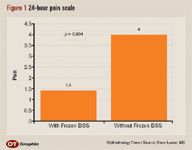Article
Use of preoperative semi-frozen BSS drops helps reduce pain after epi-LASIK
Hinsdale, IL-Preoperative topical application of semi-frozen balanced salt solution (BSS) given immediately before the epi-keratome pass is a highly effective technique for significantly reducing or even eliminating pain after epi-LASIK, said Bruce Larson, MD, who is a clinical instructor, Loyola University Medical Center, Maywood, IL, and in private practice in Hinsdale, IL.
Hinsdale, IL-Preoperative topical application of semi-frozen balanced salt solution (BSS) given immediately before the epi-keratome pass is a highly effective technique for significantly reducing or even eliminating pain after epi-LASIK, said Bruce Larson, MD, who is a clinical instructor, Loyola University Medical Center, Maywood, IL, and in private practice in Hinsdale, IL.

At their 1-day postoperative visit, patients were asked to rate their pain during the preceding 24 hours using a scale of 0 (none) to 10 (worst pain ever experienced). Patients who had bilateral surgery were asked to rate pain in each eye separately.
"While various surveys show surface ablation procedures are making a comeback, two major limitations that continue to limit their popularity are their association with postoperative pain and slower visual recovery compared with LASIK," Dr. Larson said. "We believe preoperative application of semi-frozen BSS drops offers a simple, safe, and effective method for reducing postoperative pain and thus has eliminated one of the two main barriers to surface ablation."
The semi-frozen BSS is prepared by placing the sterile 15-ml bottles in their sterile plastic containers in the freezer overnight and removing them just before the procedure. To thaw the BSS partially so that the bottle contents are about 50% fluid, it is either warmed by rotating the bottle between the hands or by placing it in the microwave for a few seconds.
Dr. Larson's administers oral prednisone (40 mg) 30 to 45 minutes before the procedure. Then, after the usual topical anesthetic drops are administered, the semi-frozen BSS drops are applied at a rate of about 1 to 2 drops per second for a total of 40 to 50 drops. Excess fluid runoff temporally is captured using a 4- × 4-inch gauze pad, and a Weck Cel sponge is used to absorb any excess fluid from the ocular surface. Then, the epi-LASIK procedure proceeds with application of the epikeratome suction ring.
"Patients do note a 'brain freeze' sensation after the application of about 20 to 30 drops," Dr. Larson said.
To address the possibility that the tonicity of the solution is different than the original BSS, Dr. Larson submitted the semi-frozen BSS for testing of specific gravity and osmolality.
These tests were performed by the clinical labs at Hinsdale Hospital, Hinsdale, IL. Initial specific gravity tests were performed using two bottles of BSS. They showed the "early melted fluid," representing the liquid used on the eye and obtained when half of the bottle contents are thawed, was more concentrated than the "late melted fluid" derived from thawing of the iceball remaining in the bottle (1.006 to 1.016 g/ml versus 1.002 to <1.005 g/ml, respectively). Those results were consistent with the osmolality testing that showed a higher osmolality of the early versus late melted fluid (392 to 423 versus 174 to 211, respectively). Standard BSS solution, which is not frozen, has an osmolality of 301, he noted.
No detectable adverse effects




